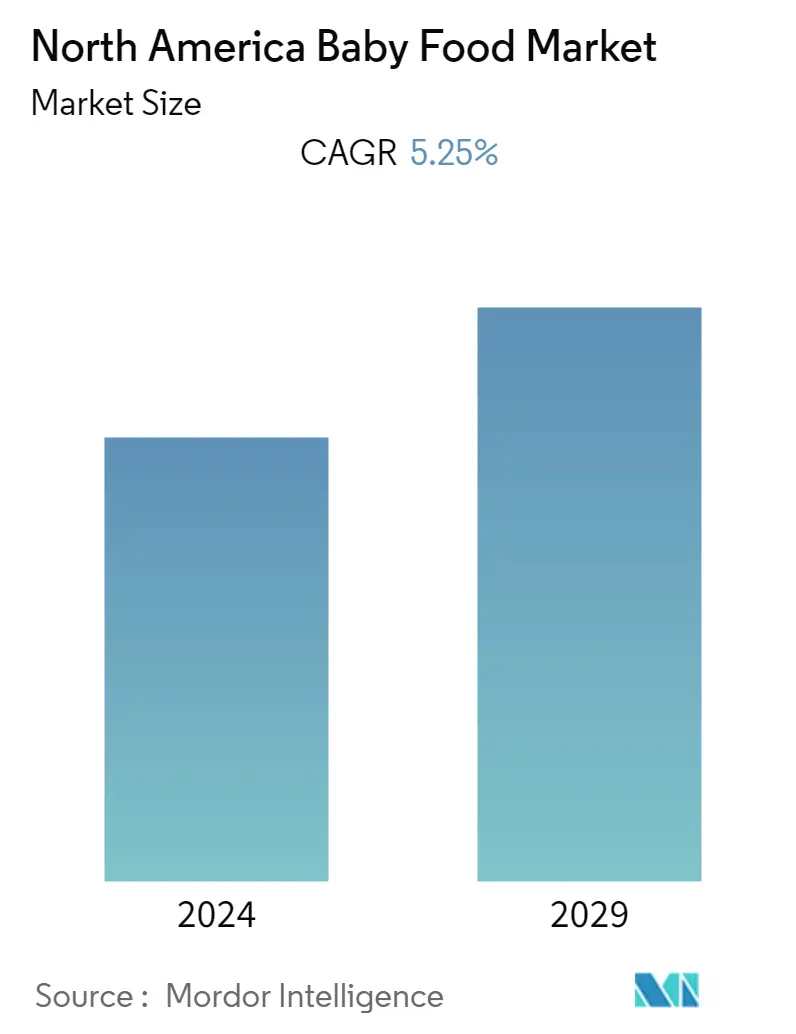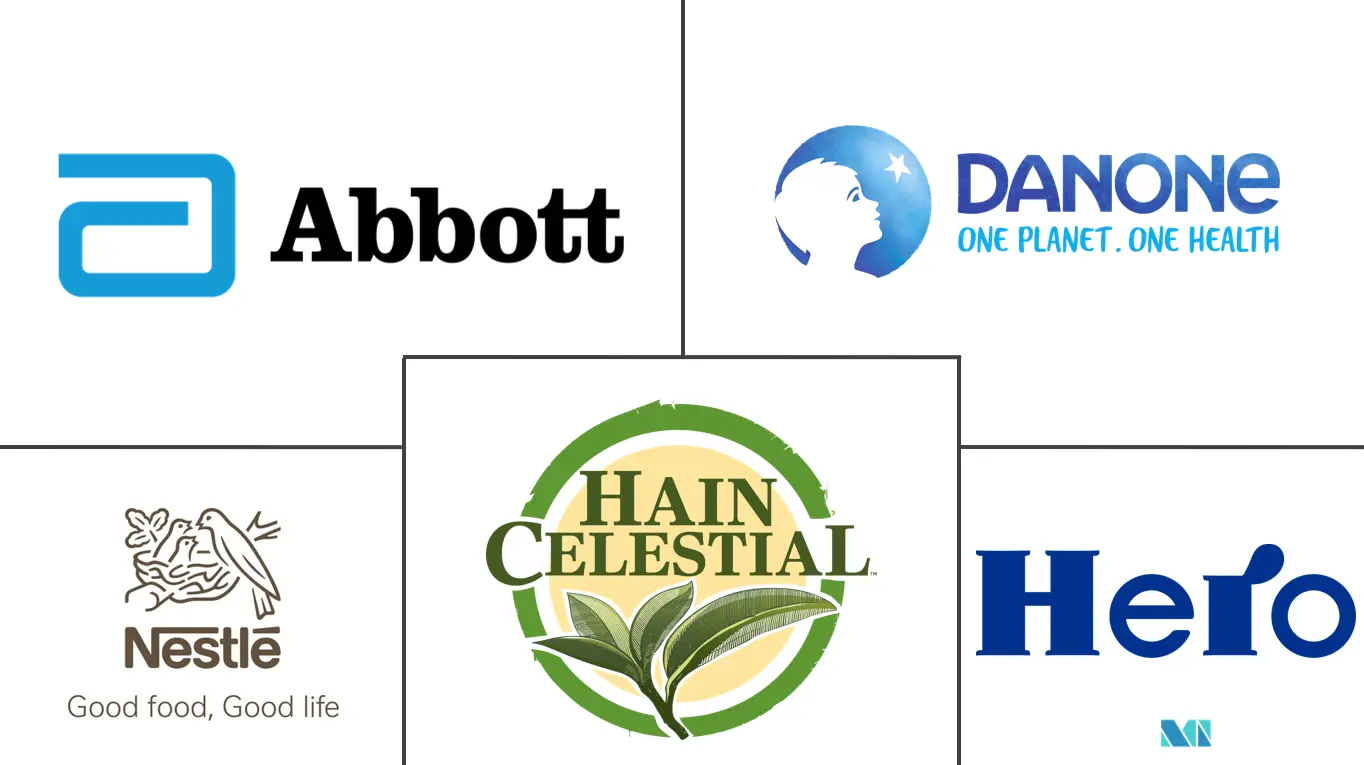Market Size of North America Baby Food Industry

| Study Period | 2019 - 2029 |
| Base Year For Estimation | 2023 |
| Forecast Data Period | 2024 - 2029 |
| Historical Data Period | 2019 - 2022 |
| CAGR | 5.25 % |
| Market Concentration | Low |
Major Players
*Disclaimer: Major Players sorted in no particular order |
North America Baby Food Market Analysis
The North American baby food market is projected to register a CAGR of 5.25% over the next five years.
- Today's young American parents want the best food to be served to their children and are conscious of the nutrient content their children take, irrespective of the product's cost. Infants and children are vulnerable to foodborne illnesses because their immune systems are not fully developed to fight infections. Thus, factors like premium quality products and their safety are among the essential criteria influencing the buyer's decision. Due to the convenience and improved nutrition that packaged baby food provides, parents have increasingly adopted it over the past few years.
- A rise in public knowledge of the numerous health benefits of feeding newborn baby food has significantly fueled the growth of the baby food market in North America. It's not surprising that parents choose organic, GMO-free, and additive/preservative-free items for their children as consumers choose fewer processed foods.
- Although parents desire greater flavor, they do not desire additional sugar and are monitoring their child's calorie intake. Instead, parents concur that producers can enhance cereal's flavor and nutritional value by incorporating superfoods like blueberries and pomegranates and a wider choice of whole grains.
- There's plenty at stake for the baby care manufacturers, as the competition in the baby care markets is stiff due to the presence of numerous branded and store-brand products offering their products at a competitive price. The existing baby food manufacturers have expanded their product ranges to include organic variants, sometimes through mergers and acquisitions. New entrants have also forayed into this sector with specialized offerings to tap the vast potential.
- For instance, in July 2020, the early childhood nutrition leader, Gerber, expanded its organic snacks line with the introduction of Gerber Organic BabyPops™, new puffed corn and oat snack in a fun, popcorn-like shape made just the right size for little fingers learning to pick up. BabyPops come in three varieties - peanut, tomato and banana raspberry - and do not contain any added sweetener or salt, plus organic is always non-GMO..
North America Baby Food Industry Segmentation
Baby food is any readily digestible, soft meal created specifically for infants between the ages of four to six months and two years old. It does not include breastmilk or infant formula.
The North American baby food market is segmented by product type, distribution channel, and geography. The baby food market, by product type, is segmented as milk formula, dried baby food, prepared baby food, and other product types. By distribution channel, the market is segmented into hypermarkets/supermarkets, convenience stores, drug/pharmacies, online retail stores, and other distribution channels. By geography, the market is segmented into the United States, Canada, Mexico, and the Rest of North America.
For each segment, the market sizing and forecasts have been done on the basis of value (in USD million).
| Product Type | |
| Milk Formula | |
| Dried Baby Food | |
| Prepared Baby Food | |
| Other Product Types |
| Distribution Channel | |
| Hypermarket/Supermarket | |
| Drugstores/Pharmacies | |
| Convenience Stores | |
| Online Retail Stores | |
| Other Distribution Channels |
| Geography | |
| United States | |
| Canada | |
| Mexico | |
| Rest of North America |
North America Baby Food Market Size Summary
The North American baby food market is experiencing significant growth, driven by a shift in consumer preferences towards premium, safe, and nutritious products. Parents in the region are increasingly opting for packaged baby food due to its convenience and enhanced nutritional value, with a strong preference for organic, GMO-free, and additive-free options. The market is characterized by intense competition, with numerous established brands and new entrants expanding their product offerings to include organic variants and specialized formulations. This competitive landscape is further fueled by strategic mergers and acquisitions, as companies strive to capture a larger market share and meet the evolving demands of health-conscious consumers. The rise in dual-income families and the busy lifestyles of parents have also contributed to the growing demand for ready-to-eat baby foods, with innovative packaging solutions like spouted squeeze pouches enhancing convenience.
In addition to changing consumer preferences, the North American baby food market is influenced by regulatory standards and increasing awareness of nutritional diets for infants. The United States, with its high birth rate and significant market share, leads the region's growth, supported by the expanding e-commerce sector that offers greater accessibility to baby food products. The market is witnessing a strong penetration of prepared organic baby food, driven by the demand for convenience and the popularity of pouches and cup holders. Key players in the industry, such as Hero Group, Nestlé S.A., Danone S.A., Abbott Laboratories, and Hain Celestial Group, are focusing on expanding their product portfolios and enhancing their global presence through strategic partnerships and acquisitions. These efforts are aimed at meeting the increasing demand for innovative and sustainable baby food solutions, as evidenced by recent product launches and acquisitions in the market.
North America Baby Food Market Size - Table of Contents
-
1. MARKET DYNAMICS
-
1.1 Market Drivers
-
1.2 Market Restraints
-
1.3 Porter's Five Force Analysis
-
1.3.1 Threat of New Entrants
-
1.3.2 Bargaining Power of Buyers/Consumers
-
1.3.3 Bargaining Power of Suppliers
-
1.3.4 Threat of Substitute Products
-
1.3.5 Intensity of Competitive Rivalry
-
-
-
2. MARKET SEGMENTATION
-
2.1 Product Type
-
2.1.1 Milk Formula
-
2.1.2 Dried Baby Food
-
2.1.3 Prepared Baby Food
-
2.1.4 Other Product Types
-
-
2.2 Distribution Channel
-
2.2.1 Hypermarket/Supermarket
-
2.2.2 Drugstores/Pharmacies
-
2.2.3 Convenience Stores
-
2.2.4 Online Retail Stores
-
2.2.5 Other Distribution Channels
-
-
2.3 Geography
-
2.3.1 United States
-
2.3.2 Canada
-
2.3.3 Mexico
-
2.3.4 Rest of North America
-
-
North America Baby Food Market Size FAQs
What is the current North America Baby Food Market size?
The North America Baby Food Market is projected to register a CAGR of 5.25% during the forecast period (2024-2029)
Who are the key players in North America Baby Food Market?
Hero Group (Beech-Nut Nutrition Corporation), Nestlé S.A., Danone S.A., Abbott Laboratories and Hain Celestial Group, Inc. are the major companies operating in the North America Baby Food Market.

